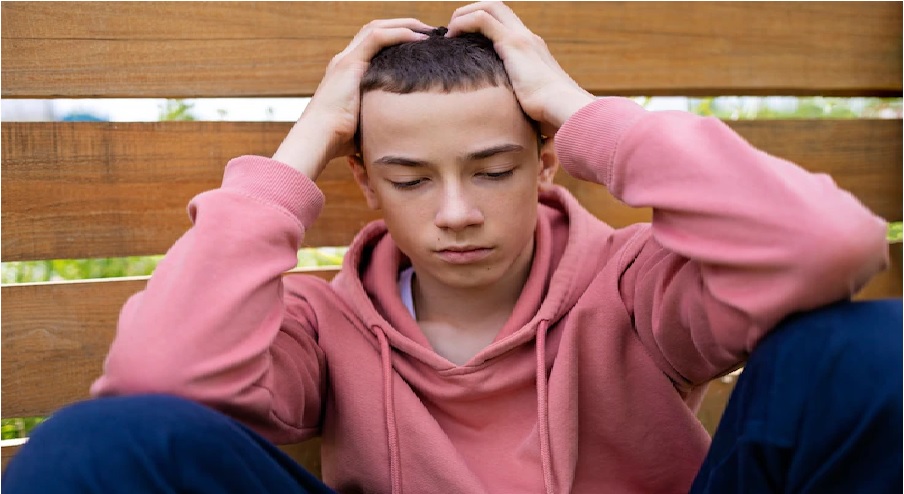Table of Contents
Introduction
In this article, will talk about reason of Depression and Stress in Youth-Depression and anxiety are on the rise among young people in today’s world, putting enormous pressure on their health and development. This phenomenon is caused by the interaction of factors such as academic pressure, social expectations, technological developments, and changing family dynamics. Depression caused by persistent depression and hopelessness, combined with the stress from the demands and pressures of daily life, has become a problem affecting young people.
The transition from youth to adulthood is marked by physical, emotional, and mental changes that make young people vulnerable to mental health problems. Academic competition and the pursuit of future goals often lead to intense stress, creating a stressful environment.
These challenges are exacerbated by the emergence of digital communications and social networks, where cyber interactions and constant comparisons increase the stress of isolation and scarcity.
It is important to understand the complexity of youth depression and anxiety because they not only affect people’s health but also have long-term potential. Untreated mental health problems in this developmental period can hinder personal development, disrupt relationships, and interfere with education and employment.
Therefore, extensive research and effective interventions are essential to address these issues and provide young people with the necessary tools to cope and overcome these mental health issues. In conclusion, the increase in depression and anxiety in young people needs urgent attention.
By investigating the causes and consequences of these problems, people can create an environment that improves their mental health, enables young people to cope with the challenges of today’s life, and raises strong people who can look to the future with strength and hope.
Reason of Depression and Stress in Youth
Depression and anxiety in youth; It results from the interaction of many factors, including biological, psychological, social, and environmental effects. Some of the main mental health problems seen in youth are as follows:
Academic Stress: High expectations and intense competition in education can lead to chronic stress and emotional distress, leading to depression and anxiety.
Peer pressure and social comparison: The need to conform and conform to social standards can lead to constant comparison with peers, leading to isolation, belief identity, and depression.

Family Dynamics: Poor family relationships, lack of motivation, or family expectations can cause stress and affect mental health.
Technology Impact: Overuse of digital devices and social media platforms can lead to cyberbullying, disrupted sleep, and increased stress levels, all of which contribute to stress and difficulties.
Economic Uncertainty: Young people may experience stress due to financial instability, future employment concerns, and the struggle to achieve financial independence.
Self and Self-Discovery: Adolescence and Early Development is a time of self-discovery. Difficulties with self-identification and purpose can lead to feelings of confusion, isolation, and depression.
Trauma and life events: Traumas such as abuse, falls, or accidents can cause depression and anxiety, especially if there is no appropriate solution.
Biological factors: Genetic predisposition, chemical imbalances in the brain, and hormonal changes during adolescence may lead to the development of depression.
Lifestyle factors: Malnutrition, lack of exercise, lack of sleep, and alcohol use can increase stress levels and lead to stress.
Social Isolation: Modern lifestyles and dependence on virtual interactions can lead to reduced face-to-face interactions, which can lead to loneliness and difficulties.

Pressure to succeed: Society’s many expectations for excellence in academic, professional, and personal life can be overstressed, leading to depression and insecurity.
Stigma and lack of support: Stigma related to mental health problems can prevent young people from seeking help, make them depressed, and cause a period of sadness and anxiety.
Addressing these principles requires a comprehensive approach that includes education, early intervention, access to mental health services, environmental support, and open communication.
By understanding and addressing these causes, people can work to create a more supportive and caring environment for young people’s health.
Health Risk because of Depression and Stress in Youth
Depression and chronic stress can wreak havoc on the body and mind. The interplay between mind and body means that the impact of these mental health problems goes beyond mere thought. The health effects of depression and anxiety are as follows:
Physical Health Problems: Chronic depression and anxiety are associated with an increased risk of many physical health problems. These include cardiovascular problems (such as heart disease and high blood pressure), physical inactivity, gastrointestinal problems, and chronic pain.
Poor Sleep: Depression and anxiety can disrupt sleep patterns, causing insomnia or sleep disorders.
Sleep is essential for physical and mental recovery, and insufficient sleep can lead to further mental health problems.

Weak Immune System: Chronic stress and depression can affect the functioning of the immune system, making a person more susceptible to infections and diseases.
Weight Loss: Depression can cause changes in appetite, which can lead to weight gain or loss. Chronic stress can lead to overeating or unhealthy eating habits that lead to obesity or other health problems.
Addiction: Some people may turn to alcohol, drugs, or other substances to cope with their mental illness, which can lead to addiction problems that affect overall health.
Chronic Pain: Depression and anxiety can affect a person’s ability to function effectively by causing pain to worsen or worsen.
Heart Risk: Stress and depression can increase heart rate, blood pressure, and pain, which can increase your risk of heart attack and stroke.
Hormonal Imbalances: Chronic stress can disrupt hormones in the body, which can affect growth, menstruation, and even fertility.
Cognitive Impairment: Both depression and chronic stress damage the brain, affecting memory, thinking, decision-making, and problem-solving.
Social Isolation: Mental health problems can lead to social isolation and isolation that negatively affects people’s lives, leading to increased anxiety and depression.
Suicidal Thoughts: Depression can be so severe that people may contemplate or attempt suicide.
Decline in Quality of Life: The effects of physical and mental health problems can reduce a person’s overall quality of life, making it difficult to perform daily activities and enjoy life.
Depression and Stress in Youth
key Solutions to Consider for Depression and Stress in Youth
Addressing depression and stress in youth requires a comprehensive and multifaceted approach that involves individuals, families, schools, communities, and society at large. Here are some key solutions to consider:
Promote Mental Health Education: Incorporate mental health education in schools to raise awareness, reduce stigma, and teach coping skills. Educate students, parents, and teachers about the signs of depression and stress.
Access to Mental Health Services: Increase access to affordable and culturally sensitive mental health services. Schools, colleges, and community centers can provide counseling and support for young individuals.
Parental and Family Support: Encourage open communication between parents and children about mental health. Strong family support can create a protective buffer against the negative effects of stress and depression.

Healthy Coping Mechanisms: Teach effective coping strategies such as mindfulness, meditation, exercise, art, and journaling to help youth manage stress and emotions.
Balanced Academic Pressure: Reevaluate academic systems to reduce excessive pressure. Emphasize holistic development, skill-building, and personal growth rather than solely focusing on grades.
Limit Screen Time: Encourage healthy digital habits and set limits on screen time, especially for social media. Encourage face-to-face interactions and outdoor activities.
Promote Physical Health: Encourage regular exercise, a balanced diet, and adequate sleep to support both physical and mental well-being.
Create Supportive Environments: Schools, colleges, and workplaces can foster environments that prioritize mental health. Implement policies that accommodate mental health needs and promote a healthy work-life balance.
Early Intervention: Identify signs of depression and stress early. Schools, parents, and healthcare providers should collaborate to intervene promptly when issues arise.
Peer Support Programs: Establish peer support groups or mentoring programs where young individuals can connect, share experiences, and offer each other support.
Media Literacy: Teach critical media literacy skills to help youth navigate the pressures and unrealistic standards portrayed on social media.
Address Bullying: Schools and communities should have strict anti-bullying policies in place and provide resources for victims and perpetrators to address this source of stress.
Counseling Services: Employ more school counselors and mental health professionals to provide guidance and support to students facing mental health challenges.
Work-Life Balance: Encourage a balanced approach to academics, extracurricular activities, and personal interests. Avoid overloading schedules.
Government Initiatives: Governments should allocate resources to mental health programs, research, and awareness campaigns targeting youth mental health.
Destigmatization Efforts: Encourage public figures, celebrities, and influencers to openly discuss their mental health experiences, reducing stigma and normalizing seeking help.
Community Engagement: Engage communities to create safe spaces for youth to discuss mental health, express themselves, and receive support.
Holistic Assessment: Encourage educational institutions to assess students holistically, considering not just academic achievements but also mental and emotional well-being.
FAQs about Depression and Stress in Youth

Teenagers and depression: How does it affect them?
Teens may be depressed if depression lasts for weeks or months and affects daily life. Symptoms of depression in adolescents include anger, trouble sleeping, feelings of worthlessness or guilt, eating more or less than usual, and weight gain, increase or decrease.
Why does depression happen to young people?
Although no one can fully explain why, many experts say that today’s youth will experience more stress at home or school, worry about the financial situation of their household, and experience more alcohol and drug use.
What causes depression and anxiety in young people?
There are many causes of depression and anxiety in young people. These factors include genetics, trauma, environment, brain differences, substance abuse, adolescent stress, and negative thought patterns.
Which age groups are affected by depression?
The average age of onset of major depression is between 35 and 40. Early onset may be associated with more stress, longer duration, and a more difficult treatment process.
What percentage of teens suffer from depression?
About 3.2 percent of American children and adolescents are diagnosed with depression. While depression has long been viewed as an adult problem, researchers now know that it can affect even children as young as 2 years old.
How can I resolve my depression?
Here are nine ways people with depression can help themselves overcome or reduce symptoms of mild to moderate depression.
- Go and play…
- Challenge negative thinking.
- Eating regular meals.
- Get enough sleep.
- Drink lots of water.
- Change action.
- Laugh a lot.
- Yoga
- Stay Away from social media.
Summary
The rising prevalence of depression and stress among youth necessitates a multi-pronged approach to address these challenges. Academic pressures, social comparisons, family dynamics, technological influences, and economic uncertainties contribute to these issues.
Their impact extends beyond mental health, affecting physical well-being through disrupted sleep, weakened immune systems, and chronic health conditions. To combat this, fostering mental health education, enhancing access to professional support, promoting healthy coping mechanisms, and reevaluating academic pressures are crucial.
Encouraging open dialogue, limiting screen time, and creating supportive environments in schools, communities, and families can alleviate the stigma surrounding mental health. Early intervention, peer support programs, and balanced lifestyles further contribute to a holistic solution.
Government initiatives and media literacy efforts are essential, ultimately cultivating a society that values mental well-being, equips youth with resilience, and ensures a healthier future for them.
In this article, we have explained about the reason of Depression and Stress in Youth, Kindly message for more details.

